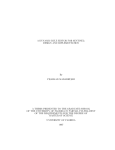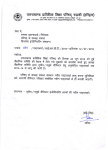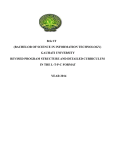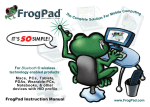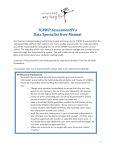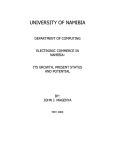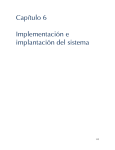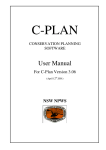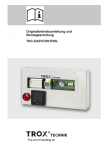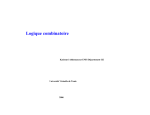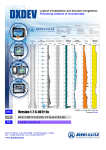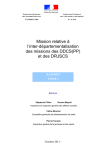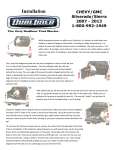Download 1 Punjab Technical University, Jalandhar B.Sc(IT) Scheme of Syllabi
Transcript
PTU/BOS/BSIT/111/09-05-2006/batch-2005 Punjab Technical University, Jalandhar B.Sc(IT) Scheme of Syllabi 1st Semester Course Subject Marks No. Int Ext Total BS-101 Communication Skills 40 60 100 BS-103 Basic Mathematics-1 40 60 100 BS-105 Programming in C 40 60 100 BS-107 Fundamentals of Information Technology 40 60 100 BS-109 Software Lab-I(C) 60 40 100 BT-111 Software Lab-II(FIT) 60 40 100 280 320 600 Total 2nd Semester Course Subject Marks No. Int Ext Total BS-102 Digital Electronics Fundamentals 40 60 100 BS-104 Mathematics - II (Discrete) 40 60 100 BS-106 RDBMS-I 40 60 100 BS-108 Data Structures through C 40 60 100 BS-110 Software Lab-III (Data Structures) 60 40 100 BT-112 Software Lab-IV (RDBMS) 60 40 100 280 320 600 Total 1 PTU/BOS/BSIT/111/09-05-2006/batch-2005 3rd Semester Course Marks Subject No. Int Ext Total BS-201 Computer System Architecture 40 60 100 BS-203 Operating System 40 60 100 BS-205 Programming in C++ 40 60 100 BS-207 System Analysis & Design 40 60 100 BS-209 Software Lab-V(C++) 60 40 100 220 280 500 Total 4th Semester Course Marks Subject No. Int Ext Total BS-202 Core Java Programming 40 60 100 BS-204 Web Technology-I 40 60 100 BS-206 Microprocessor System 40 60 100 BS-208 Computer Oriented Numerical Methods 40 60 100 BS-210 Software Lab-VI (Core Java 60 Programming) Software Lab-VII (Web Technology-I) 60 40 100 40 100 320 600 BS-212 Total 280 2 PTU/BOS/BSIT/111/09-05-2006/batch-2005 5th Semester Course Marks Subject No. Int Ext Total BS-301 Web Technology-II 40 60 100 BS-303 RDBMS-II 40 60 100 BS-305 Computer Networks 40 60 100 BS-307 Principles of Management 40 60 100 BS-309 Software Lab-VII(Web Technology-II) 60 40 100 BS-311 Software Lab-VIII(RDBMS-II) 60 40 100 BS-313 Software Lab-IX(Computer Networks) 60 40 100 340 360 700 Total 6th Semester Course Subject Marks No. Int Ext Total BS-302 Software Engineering 40 60 100 BS-304 Management Information Systems 40 60 100 BS-306 Visual Basic Programming 40 60 100 BS-308 Advanced Java Programming 40 60 100 BS-310 Software Lab-X Programming Lab) Software Lab-XI Programming) (Visual Basic 60 40 100 (Advanced Java 60 40 100 320 600 BS-312 Total 280 3 PTU/BOS/BSIT/111/09-05-2006/batch-2005 BS-101 COMMUNICATION SKILLS Nature of Communication: Process if Communication; Non-verbal Communication; Business Communication; Barriers to Communications; Global Aspects; Ethical; Legal Aspects. Communication Technology: Electronic Communication Systems; Duplication Technology; Storage Devices. Principles of Letter Writing: Nature and Functions of Letters; Principles. Structure and layout: Elements of Structure; Forms of Layout; Styles of Presentation Planning and Preparation: Importance of Planning; Five Steps of to Planning. Quotations, Order and Tenders: Inviting Quotations; Sending Quotations; Placing Order; Inviting Tenders. Sales Letters: Qualities of a Sales Letters; Writing a Sales letter. Claim and Adjustment Letters: making Claims; Offering Adjustments. Credit and collection Letters: Nature of a Credit Letters; Types of a Credit letter; Collection Procedure;; Summary of Distinctive Features of Business Letters. Handling Correspondence: Receipt and Dispatch of Mail; Noting on the Files; Filing Systems; Classification mail. Social Correspondence: Role and Function; Types. Business and technical reports: Characteristics; Importance; types; Routine reports Structure and Layout: Elements of Structure; Front Matter; main Body; Back Matter Planning and Preparation: import preparatory Steps; Source of Data; Evolution of Material, note making, organizing Material; principles of Organization; Making Outline Elements of Style: The Scientific Attitude; Readability. Use of Illustrations: purpose; Types. Technical Description : techniques of Description; Describing machines and Mechanisms; Describing Process; Sample Descriptions. Writing the report : Rough Draft ; Process of Writing ; Order of Writing; the Final Draft; Check-list for Reports. Specimen Reports : report from Industry; Socio-Cultural Survey report; technical report; Interpretive report; Letter Report. Oral Presentation : Importance of Acquiring Oral Presentation Skills; Body Language; Voice Modulation; Audience Awareness; Presentation Plan; Visual Aids; use of Connectives; Check lists; Evaluation; brochure; Conducting a Meeting; Participating in a Meeting. Application Letter: Importance and Function; Drafting the Application; Elements of Structure; preparing the resume; Helpful Hints; Job Offer; Resignation Letter. Employment Interview: Types of Interview; Preparing for the Interviews; Attending the Interview; Interview Process; Employers Expectation; Conducting an Interview; Negative Aspects. Group Discussion: Definition; Process; Guidelines; Helpful expressions; Evaluation 4 PTU/BOS/BSIT/111/09-05-2006/batch-2005 BS-103 BASIC MATHEMATICS-I RELATION AND FUNCTIONS: Elements of set methods of describing a set; types of set; operations on sets, union intersection and difference of set Duality, Partitioning of a set; trigonometric functions. BINOMIAL THEOREM AND ITS APPLICATION MATRIX: Introduction to matrix; properties of matrix; evaluation of determinant; minor and co-factors and properties of determinant. STATISTICS: Introduction to statistics, collation, and tabulation of data, mean median and mode. SERIES: AP Series, GP Series. 5 PTU/BOS/BSIT/111/09-05-2006/batch-2005 BS-105 PROGRAMMING IN C Origin & Introduction to C: About o C, Evolution of C, Programming Languages, Structure of a C program, Compiling a C program, Compiler & interpreters, Pseudopodia, Simple C program, Character set in C, Keywords in C, Hierarchy of operators, Basic Data Types, Qualifiers used with basic data types, Variable in C, Type declaration, output function, Input function and format specify, Arithmetic operators, Unary operators, Relational and logical operators, Constraints in C, Decision Making, Branching & Looping: Why control statements, the if statement, if else statement, for statement, whiled loop, do while statement, break statements,, continue statements, switch statement, go to statement, ternary operators, Arrays & String Handling’s: introduction to arrays, advantages of arrays, types of arrays, array declaration, array initialization, accessing data from array, array inside the memory, multidimensional arrays, Character arrays overflow, string Variables, Reading& writing strings, string handling functions. User Defined Function: Introduction functions, advantages of function, declaring a function, calling a function, variables, passing arguments for a function, nested function, passing array to functions, recursion in function, Call by Valve and Call reference. Pointers: Introduction to pointers, pointer variation, dynamic memory allocation, pointers and arrays, pointers to pointers functions returning pointers, 2 Dimensional arrays and pointers, array of pointers . File Management in C: Defining & opening a file , I/O operations on file, error handling during I/I operations, Random Access Files. Recommended Books: Programming in C by Balagurswami-TMH Publication 6 PTU/BOS/BSIT/111/09-05-2006/batch-2005 BSIT-107 FUNDAMENTALS OF INFORMATION TECH. Introduction: Characteristics of Computers, The Evolution of Computers, The Computers Generations (First Generation (1942-1955),Second Generation (1955-1964), Third generation (1964-75) , Fourth Generation (1975-1989), Fifth Generation (1989-present). Basic Computer Organization: Input Unit, Output unit, Storage Unit, Arithmetic Logic Unit, Control Unit, Central processing Unit, The System Concept. Number of Systems: Non-positional number Systems, Positional Number Systems (Binary Number Systems, Octal Number System, Hexadecimal Number System, Converting One System to another (Converting to Decimal from Another base , Converting form Decimal to another Base (Division-Remainder Technique), Converting form a base other than 10 to base other than 10, Shortcut method for Binary to Octal Concession, Shortcut method for Octal to Binary. Conversion, Shortcut method for Binary to Hexadecimal Conversion, Shortcut Method for Hexadecimal to binary Conversion, Fractional Numbers. Processor and Memory: The central Processing Unit (CPU) (The Arithmetic Logical Unit (ALU), Instruction Set, and registers, Processor Speed, types of Processor) The main memory (storage evalution Criteria, main memory Organization, Main memory Capacity, RAM, ROM, PROM and EPROM Cache Memory. Secondary storage Devices: Sequential and direct-Access devices, Magnetic Tape (basic Principles of Operation, Types of magnetic tapes, Advantages and Limitation of magnetic tapes, Uses of Magnetic Disks), Optical Disk (Basic Principles of Operation, Types of Optical Disks, Advantages and Limitations of Optical Disks, Uses of Optical disks, Mass storage Devices (Disk Array, Automated Tape Library, CD-ROM Jukebox), Storage Devices Hierarchy. Input-Out put Devices: Input Devices (Keyboard Devices, Point and draw Devices, Digitizer, Electronic Card reader, Voice Recognition Devices, Vision Input (system) output Devices (Monitors, Printers, projectors, Screen Image, project, Voice response Systems). Computer Languages: Analogy with natural Languages, Language (Advantages and Limitations of Machine language, Assembly Language (Assembler, Advantage of Assembly Language over machine language, Limitation of Assembly Language, Assembly Languages with Micro Industries). High Level Language (compiler, Linker, Interpreter, Advantages and Limitations of High-Level Languages) Object-Oriented Programming Languages, Some High-level Languages (Fortran, Cobol, basic, Pascal) Some More High-Level Languages (C++ and C, Java, RPG LISP, SNOBOL) Characteristics of a Good Programming Language, Selecting a Language for Coding and Application, Subprogram. 7 PTU/BOS/BSIT/111/09-05-2006/batch-2005 Application Software Package: Word-Processing Package (What It Is?, Commonly Supported Features), Spreadsheets Package (What it Is?) Commonly Supported Features, graphics Package (what it is? Commonly Supported features); Personal Assistance Package (What it is?) Commonly Supported Features). The Internet: definition (What it is?) brief History, Basic Services (Electronic Mail, Protocol, telnet Usenet, news, The world wide Web) WWW Browser, Uses of the Internet. Classification of Computers: Notebook Computers, Personal Computers (PCs) work stations, Mainframe Systems, Supercomputers, Clients and Services. MS-OFFFICE 2000 Microsoft Office 2000:- introduction,, Microsoft Word 2000, Microsoft Excel 2000, Microsoft Access 2000, Microsoft PowerPoint 2000, Microsoft Outlook 2000, Internet Explorer 5.0, Microsoft FrontPage 2000, Microsoft Publisher 2000, Microsoft Photo draw 2000, Microsoft Office bar, Using the Mouse (To Click, To double –Click, To select, To drag, To Scroll, To choose form a menu, To mover a window, to resize a window, To minimize a window, to restore a minimized Window, To maximize a window, To switch windows, To close a window, remember ) Microsoft Office 2000 and Web ((Microsoft Word 2000, Micro Excel 2000, Microsoft access 2000, Microsoft power point 2000 , Microsoft Outlook 2000, Microsoft FrontPage 2000) common Keyboard Commands. Creating Your Document in Words: Introduction, Saving the file, formatting the text Alignment of text, Applying Fonts, Spell checking, Consulting thesaurus, Assign Character Styles (Assign a Character Style (Assign a Character Style, Create a character style) borders and shading (apply Borders and Shading) Closing of the file, Save as (From file menus, from open, Icon) printing your document. Proofing Your Document in Word 2000: Introduction, Editing Tools, Auto correct (Add Auto correct Entries Without formatting, Add new auto correct entries with formatting, Auto Text (Creating an auto text entry, Auto complete option) auto format (auto format as you type auto format on command, autofomatting text) Find and replace, find replace text Page Numbering, header and footer (Adding a header or footer in our document) Footnotes and endnotes (Add a footnote or endnote Creating a Worksheet in Excel 2000: Introduction, Copying, and Formula. Advanced techniques of Excel 2000: Auditing a workbook (to trace the precedents for a formula), Comment inserting (To insert a comment) Formulas that decisions (How the If function works) Header and footers, Merging workbooks (to merge workbooks) Outlines a worksheet automatically, clear entire Outline, Show or hide outline symbols, group 8 PTU/BOS/BSIT/111/09-05-2006/batch-2005 rows of columns in an outline ungroup rows, remove group from Outline, Set outline options), printing column and Row Labels on Every page protecting a Workbook ( To unlock cells so that others can edit the cell contents, to protect a workbook to share a workbook) ranges, Naming (To name a range) references (Absolute references, Mixed references) Seeking Goals (To seek a goal) sheets Naming (To name a sheet) Working with Workbooks (Copying Entries between Workbooks, Moving Sheets between workbooks deleting sheets). Creating presentation Using auto content wizard , creating new presentation, Introduction, Changing views. Recommended Books: Computer Fundamentals- Pradeep K.Sinha, Preeti Shina-BPB Publications 9 PTU/BOS/BSIT/111/09-05-2006/batch-2005 BS-102 DIGITAL ELECTRONICS FUNDAMENTALS INSTRUCTIONS FOR PAPER-SETTER The question paper will consist of Two parts, A and B. Part A will have 15 short answer questions (40-60 words) of 2 marks each. Part B will have 12 long answer questions of 5 marks each. The syllabus of the subject is divided into 3 sections I, II and III. The question paper will cover the entire syllabus uniformly. Part A will carry 5 questions from each section and Part B will carry 4 questions from each section. INSTRUCTION FOR CANDIDATES Candidates are required to attempt all questions from Part A and 9 questions of Part B out of 12. Section I FUNDAMENTAL CONCEPTS: Introduction, Digital Signals, Basic digital circuits (AND Operation, NOT Operation, OR Operation), NAND and NOR Operations, Exclusive - OR Operation, Boolean Algebra, Examples Of IC Gates. NUMBER SYSTEMS AND CODES: Introduction, Number Systems, Binary Number System(Binary to Decimal Conversion, Decimal to Binary Conversion), Signed Binary Numbers(Sign Magnitude Representation, 1's Complement Representation, 2's Complement Representation), Binary Arithmetic (Binary Addition, Binary Subtraction, Binary Multiplication, Binary Division), 2's Complement Arithmetic (Subtraction using 2's Complement, Addition/Subtraction using 2's Complement), Octal Number System(Octal to Decimal Conversion, Octal to Binary Conversion, Decimal to Octal Conversion, Binary to Octal Conversion, Octal Arithmetic, Applications of Octal Number System), Hexadecimal Number System(Hexadecimal to Decimal Conversion, Decimal to Hexadecimal Conversion, Hexadecimal to Binary Conversion, Binary to Hexadecimal Conversion, Conversion from HEX to Octal and vice versa, Hexadecimal Arithmetic), Codes (Straight Binary Code, Natural BCD Code, Excess-3 Code, Gray Code, Octal Code, Hexadecimal Code, Alphanumeric Code), Error Detecting and Error Correcting Codes. COMBINATIONAL LOGIC CIRCUITS: Introduction, Standard Representation for Logical 10 PTU/BOS/BSIT/111/09-05-2006/batch-2005 Functions, Karnaugh Map Representations of Logical Functions (Representation of Truth Table on K-Map, Representation of Standard SOP Form on K-Map, Representation of Standard POS Form on K-Map),Simplification of Logical Functions Using K Map(Grouping two adjacent Ones, Grouping four adjacent Ones, Grouping 2,4 and 8 adjacent Ones), Minimization of Logical Functions Specified in Minterms/Maxterms or Truth Table (Minimization of SOP Form, Minimization of POS Form), Minimization of Logical Functions not specified in Minterms/Maxterms, Don't Care Conditions, Design Examples( Airthematic Circuits, BCD to 7 Segment Decoder), EX-OR AND EX-NOR Simplification of K-Maps(Diagonal and Offset Adjacencies of Groups of Ones), Five and Six Variable K-Maps, Quine-Mc Cluskey Minimization Technique. Section II COMBINATIONAL LOGIC DESIGN USING MSI CIRCUITS: Introduction, Multiplexers and Their use in Combinational Logic Design ( Multiplexer, Combinational Logic Design Using Multiplexers, Multiplexer Tree), Demultiplexers/Decoders and their use in Combination Logic Design(Demultiplexer, Demultiplexer Tree), Address and their use as Subtractors (Adder with Look Ahead Carry, Cascading of Adders, Subtraction Using Adder), BCD Arithmetic (BCD Adder, BCD Subtractor), Arithematic and Logic Unit(ALU). FLIP FLOP's : Introduction, A 1-Bit Memory Cell, Clocked S-R Flip-Flop (Preset and Clear), J-K Flip-Flop (Race around Condition, Master Slave JK Flip Flop), D-Type Flip Flop, TType Flip Flop, Excitation Table of Flip Flop, Clocked Flip Flop Design (Conversion from one type of Flip Flop to Another Type), Edge Triggered Flip Flop's, Application of Flip Flop's (BounceElimination Switch, Registers, Counters, Random Access Memory). Section III SEMICONDUCTOR MEMORIES :Introduction, Memory Organization and Operation (Write 11 PTU/BOS/BSIT/111/09-05-2006/batch-2005 Operation, Read Operation), Expanding Memory Size (Expanding Word Size, Expanding Word Capacity), Classification and Characteristics of Memories (Principle of Operations, Physical Characteristics, Mode Of Access, Fabrication Technology), Sequential Memory(Static Shift Register, Dynamic Shift Register), Read Only Memory (ROM Organization, Programming Mechanisms, ROM IC's), Read and Write Memory(Bipolar RAM Cell, MOS RAMs, RAM ICs), Content Addressable Memory(Operation of CAM), Charge Coupled Device Memory(BAsic Concept of CCD, Operation of CCD, A Practical CCD Memory Device). Reference Books :1. Tokheim, Digital Electronics: Principles & Applications 2. Taub, Herbert, Digital Integrated Electronics 3. Mithal, G.K., Pulse & Digital Electronics 4. Jain, R.P., Modern Digital Electronics 5. Malvino, Digital Electronics Principles 6. Malvino, Digital Principles & Applications 12 PTU/BOS/BSIT/111/09-05-2006/batch-2005 BS-104 MATHEMATICS - II (DISCRETE) INSTRUCTIONS FOR PAPER-SETTER The question paper will consist of Two parts, A and B. Part A will have 15 short answer questions (40-60 words) of 2 marks each. Part B will have 12 long answer questions of 5 marks each. The syllabus of the subject is divided into 3 sections I, II and III. The question paper will cover the entire syllabus uniformly. Part A will carry 5 questions from each section and Part B will carry 4 questions from each section. INSTRUCTION FOR CANDIDATES Candidates are required to attempt all questions from Part A and 9 questions of Part B out of 12. Section I SET THEORY :Set & Its elements, Set description, Types of Sets, Ven-Euler Diagrams, Basic Set Operations, Fundamental products, Partitions of Sets, Minsets, Algebra of Sets & Duality. RELATIONS & DIAGRAPHS : Cartesian Product of sets, Binary relations, Representation of relations on finite sets, Path in relations & diagraphs, Types of relations, Composition of relations. FUNCTIONS : Definition & notation of a function, Types of functions, Invertible functions, Composition of functions, Functions for computer science, Set representation in a Computer, Greatest common divisor, Least Common Multiple. Section II MATHEMATICAL INDUCTION : Principle of Mathematical Induction. PERMUTATIONS & COMBINATIONS : Role of Sum & Product, Permutations (Important deductions, Permutations with Repetition of Objects, Circular Permutations, Restricted Permutations), Combinations (Important Results, restricted combinations, combinations of objects not all different). Section III 13 PTU/BOS/BSIT/111/09-05-2006/batch-2005 RECURRENCE : Recurrence relation, Linear recurrence relation with constant coefficients, Solution of Linear recurrence relation with constant coefficients, Solution of nonhomogeneous recurrence relations, Methods of generating functions. MATHEMATICAL LOGIC : Prepositional Calculus, Basic Logical operations (Conjuction, disjunction, Negation, derived connectives), Statements generated by a set, conditional statements, Converse Inverse & Contrapositive statements, Biconditional statements, Tautologies, Contradiction, Contigency, Argument, Methods of proof, Equivalence & Implication, Statement Calculus. BOOLEAN ALGEBRA : Laws of Boolean algebra, Basic Theorems, Duality Principle, Bolean Functions, Applications of Boolean Algebra. Reference Books:1. Lipschutz, Seymour, Discrete Mathematics (Schaum Series) 2. Kolman, Bernard, Discrete Mathematical Structures 3. S.B. Singh, Discrete Structures 4. Bhupinder Singh, Discrete Mathematics & Its Applications 5. Rm. Somasundram, Discrete Mathematical Structures. 14 PTU/BOS/BSIT/111/09-05-2006/batch-2005 BS-106 RDBMS-I INSTRUCTIONS FOR PAPER-SETTER The question paper will consist of Two parts, A and B. Part A will have 15 short answer questions (40-60 words) of 2 marks each. Part B will have 12 long answer questions of 5 marks each. The syllabus of the subject is divided into 3 sections I, II and III. The question paper will cover the entire syllabus uniformly. Part A will carry 5 questions from each section and Part B will carry 4 questions from each section. INSTRUCTION FOR CANDIDATES Candidates are required to attempt all questions from Part A and 9 questions of Part B out of 12. Section I Introduction to Office 2000: Introduction Microsoft Office 2000, Benefits of Office 2000, What is New in Office 2000, Overview of Office 2000, Launching Office 2000 Applications, Switching between Office 2000 Applications, Office 2000 Help System, Detect & Repair Windows, Menus and Toolbars, Closing (Existing) Office Applications, Windows, Menus, Dialog Boxes and Toolbars, Application Windows, The Application’s Workplace, Document Navigation, Working with Several Document Windows, Menus and Dialog Boxes, Dialog Box Options,Toolbars, Printing Documents, Exercises. Introduction to Databases, DBMS and RDBMS : Introduction, Information, Quality of Information, Information Processing, What is a Database?,Why a Database?, Charateristics of Data in a Database, What is a Database Management System (DBMS)?, Need for DBMS, Types of DBMS, Relational Database Management Systems (RDBMS), RDBMS Terminology, Relational Data Structure, Relational Data Intergrity, Conclusion, Review Questions. Section II Access 2000 Basics : Introduction, Starting Access 2000, Access Startup Dialog Box, Menus and Toolbars, Using Toolbar Buttons, Arranging Buttons on the Toolbar, Viewing Data, Creating an Access 2000 Database and Tables, Database Properties, Modifying Tables, Creating Forms, 15 PTU/BOS/BSIT/111/09-05-2006/batch-2005 Entering and Updating Data Using Forms, Navigating between Records in a Form, Finding, Editing and Deleting Data in a Form, Using Access 2000 Help, Using Answer Wizard, Using the Contents Tab to Get Help, Using the Index Tab to ger Help, Exercises. Report and Queries : Introduction, Sorting and Filtering Records, Creating and Printing Reports, Creating and Using Queries. Section III Introduction to Structured Query Language (SQL) : Introduction, Characteristics of SQL, Advanges of SQL, Types of SQL Tables, Create Table, NULLS, Data Manipulation, Update Operations, SQL in Access. Query by Example (QBE) : Introduction, SELECT Queries in QBE, Make-Table Query, DELETE Query, UPDATE Query, APPEND Query, Conclusion, Exercises. Reference Books:1. Ullman, Principles of Database Systems 2. Kroenke, D, Database Processing 3. Naveen Parkash, Introduction to Database Management 16 PTU/BOS/BSIT/111/09-05-2006/batch-2005 BS-108 DATA STRUCTURES THROUGH C INSTRUCTIONS FOR PAPER-SETTER The question paper will consist of Two parts, A and B. Part A will have 15 short answer questions (40-60 words) of 2 marks each. Part B will have 12 long answer questions of 5 marks each. The syllabus of the subject is divided into 3 sections I, II and III. The question paper will cover the entire syllabus uniformly. Part A will carry 5 questions from each section and Part B will carry 4 questions from each section. INSTRUCTION FOR CANDIDATES Candidates are required to attempt all questions from Part A and 9 questions of Part B out of 12. Section I Analysis of Algorithms : Why Analyze Algorithms?; What is Analysis?; What Analysis doesn’t do?; What to count and consider?; Cases to Consider during Analysis; Rates of Growth; Analysis of Sequential Search Algorithm (Worst Case Analysis, Average Case Analysis). Arrays : What are Arrays?; Array Operations; Merging of Two Arrays; TwoDimensional Arrays (Row Major and Column Major Arrangement, Common Matrix Operations, More Matrix Operations); Array of Pointers; Multidimensional Arrays; Arrays and Polynomials; Multiplication of Polynomials. Strings : What are Strings?; Representation of Strings; Operations on Strings; Pointers and Strings; A Two-Dimensional Array of Strings; Array of Pointers to Strings; Limitation of Array of Pointers to Strings; Pattern Matching (Brute Force Algorithm); Few More String Functions. Section II Linked Lists : What is a Linked List?; Operations on Linked Lists; Ascending Order Linked Lists; Reversing the Links; Merging of Linked Lists; Sorting a Linked List; Circular Linked List (Function delcirq(), Function cirq_display()); A few more Operations; Recursive Operation on Linked Lists; 17 PTU/BOS/BSIT/111/09-05-2006/batch-2005 Doubly Linked Lists (Function d_append(), Function d_addatbeg(), function d_addafter(), function d_delete()); Linked Lists and Polynomials (Function poly_multiply(), Function padd()). Sparse Matrices : Representation of Sparse Matrix as an Array; Common Matrix Operations; Transpose of a Sparse Matrix; Addition of Two Sparse Matrices; Multiplication of Two Sparse Matrices; Linked Representation of a Sparse Matrix; Other forms of a Sparse Matrix. Stacks : Operations on Stack; Stack as an Array; Stack as a Linked List; Applications of Stacks; Infix to Prefix Conversion; Infix to Post-fix conversion; Postfix to prefix conversion; postfix to infix conversion; Evaluation of Postfix expression. Queues : Representation of Queue as an Array; Representation of a Queue as a Linked List; Circular Queues; Dequeue; Priority Queue; Array Implementation of a Priority Queue. Section III Trees : Binary Trees; Traversal of a Binary Tree; Representation of a Binary Trees in Memory (Linked Representation of Binary Trees, Array Representation of Binary Trees, Binary Search Trees); Operations on a Binary Search Tree (Searching of a Node in a BST, Insertion of a Node in a BST, Deletion from a Binary Tree, Applications of Binary Trees (Representing Expressions In Binary Trees). Searching and Sorting : Searching (Linear Search, Binary Search, Comparison of Linear Search and Binary Search); Sorting (Internal Sorting, External Sorting); Internal Sorting (Bubble Sort, Selection Sort, Quick Sort, Insertion Sort); External Sorting. Reference Books:1. Radhakrishnan, M, Data Structuring Using C. 2. Weiss, Mark Allen, Data Structures & Algorithm Analysis in C. 18 PTU/BOS/BSIT/111/09-05-2006/batch-2005 BS-201 COMPUTER SYSTEM ARCHITECTURE Introduction to Digital Computer : Introduction; Evolution of Computers (Abacus (5000 B.C.), Pascal and Leibniz Calculators, Babbage Difference Engine, Difference/Analytical Engine, Herman Hollerith Punch Cards, Howard Aiken (1937):IBM Mk1, ENIAC (1946), UNIVAC-1(1951), Second Generation (1959-65), Third Generation (1965-70), Fourth Generation (since 1970), Fifth Generation (under development)). Basic Computer Design : Introduction; Computer Registers (General Purpose Registers, Accumulator, Status Register, Program Counter, Stack Pointer (SP), Word Size and Register Size); Main Memory; Interfacing Various Registers (Data Movement among Registers, Selection Control Variables); Computer Instructions (Direct Addressing Mode, Memory Reference Instructions, Register Reference Instructions, Input and Output Instructions); Timing Signals; Timing and Control (Sequence Counter, Control Logic Gates for Inputs/Outputs, Timings, How Fetch Cycle Works?, How Execution Cycle Works?, How an Instruction is Executed?); Microoperations ( Memory Reference Instructions, Register-Reference Instructions); Concept of Interrupt (Interrupt Cycle); Design of a Basic Computer and its Working (Control of Registers, Control of Memory, Control of Common Bus, Control of Flip-flops). Central Processing Unit (CPU) Organization : Introduction; Addressing Modes; Instruction Formats (Instruction Types); Stack Organized CPU (How POP and PUSH functions are performed in Stack?, Reverse Polish Notation or Postfix Notation, How to convert Infix Expression into Postfix Expression?); What are the factors affecting instruction Length?; Program Control (External interrupts, Internal Interrupts, Software interrupts); General Register Organization; Arithmetic Logic Unit (Status Register, Design of Accumulator Logic Unit). Programming Basic Computer: Introduction: Machine Language; Assembly Language (Pseudo-instruction, Rules of Assembly Language, Programming in Assembly Language, Subroutine Data linkage, Shift Operations, Concept of Interupt, Ad Input-Output Organization : Introduction; Peripheral Devices (Input Devices, Output Devices); Synchronous and Asynchronous Communications; I/O (Input/Output) Interface (Parallel and Serial Ports); Modes of Data Transfer (Programmed I/O, Interrupt-initiated I/O, Polling, Direct Memory Access (DMA)); Interrupt (Software Interrupt, Hardware Interrupt); Priority Interrupt (Vectored Interrupt, Non-vectored Interrupt, Priority Interrupt, Daisy Chain); I/O Processor; DMA (Data Transfer through DMA, DMA controller). Memory Organization : Introduction; Memory Hierarchy (Why Hierarchical memory system?); Main Memory or Primary Memory (RAM, ROM, Memory Unit, Design of Main Memory); Auxiliary Memory (Magnetic Tape, Magnetic Disk); Cache Memory (Locality of Reference, Hit Ratio, Mapping Process, How to Write Data into Cache Memory?); Virtual Memory (Paging, Page Replacement); Memory Management Hardware (Segmentation, How Multiprogram Management is done?, Memory Protection); Associative Memory 19 PTU/BOS/BSIT/111/09-05-2006/batch-2005 BS-203 OPERATING SYSTEM INTRODUCTION :- Machine Hardware (Traps and Interrupts, Multimode Execution); Operating System Structure (Operating System Types, Operating System Kernel, The Boot Process). PROCESS MANAGEMENT :- Process Scheduling; Process State; Scheduling Criteria; Scheduling Algorithms (First-Come First-Served, Shortest Job First, Shortest Remaining Time, Round Robin, Priority, Multilevel feedback Queues); Scheduling Algorithm Performance; Process Attributes (Run State and Scheduling, Memory Management, Hardware State, Signaling, Access Control, Input and Output, Other); Process Supervisor Calls. INTERPROCESS COMMUNICATION AND SYNCHRONIZATION :- Interprocess Communication; Process Synchronization (Critical Section, Interrupt Disabling, Test and Set Instruction, Swap Instruction, Wait and Signal, Semaphores, Dekker’s Algorithm, Peterson’s Algorithm, Bakery Algorithm, Monitors); Deadlock (Deadlock Prevention, Deadlock Avoidance, Deadlock Detection, Recovery from Deadlock, Ostrich Algorithm). MEMORY MANAGEMENT :- Single Absolute Partition; Single Relocatable Partition, Multiprogramming; Multiple Partitions (Multiple Fixed Partitions, Multiple Variable Partitions (Partition Selection Algorithms); Buddy System; Simple Paging; Simple Segmentation; Segmentation with Paging; Page and Segment Tables (Associative Memory, Inverted Page Table (Swapping, Overlaying). VIRTUAL MEMORY :- Demand Paging (Locality of Reference, Page Locking, Page Size, Page Replacement Algorithms, Algorithm Performance, Allocation Policies, Working Set, Prepaging); Segmentation. FILE SYSTEM MANAGEMENT :- Directories and Names (Partitions, Per-Process Root Directory, Directory Structure, Directory Entries); Types of File System Objects; File System Functions; Information Types; File System Architecture (Access Methods, Access Control, File Locking, Blocking, Allocation, Free Space). DEVICE MANAGEMENT :- Hardware I/O Organization (I/O Control, Port and Memory-Mapped I/O, Module Registers, Busy Wait I/O, Polled I/O, Interrupt I/O, Direct Memory Access (DMA)); Software Organization (Network I/O, Logical I/O, Buffering, Caching, Device Drivers); Devices (Graphics, Text-Based Displays, Storage Disks, Hard-Disk Performance, Hard-Disk Scheduling, Formatting, Raid, RAM Disks). SECURITY :- Authentication (Passwords, Physical Authentication); Prevention; Detection; Correction; Identification; Threat Categories; Program Threats. 20 PTU/BOS/BSIT/111/09-05-2006/batch-2005 BS-205 PROGRAMMING IN C++ Principles of Object-Oriented Programming : Software Crisis; Software Evolution; A Look at Procedure-Oriented Programming; Object Oriented Programming Paradigm; Basic Concepts of Object-Oriented Programming; Benefits of OOP; Object Oriented Languages; Applications of OOP. Beginning with C++ : What is C++?, Applications of C++, A Simple C++ Program, More C++ Statements, An Example with Class; Structure of C++ Program, Creating the Source File, Compiling and Linking. Tokens, Expressions and Control Structures : Introduction; Tokens; Keywords; Identifiers; Basic Data Types; User-Defined Data Types; Derived Data Types; Symbolic Constants; Type Compatibility; Declaration of Variables; Dynamic Initialization of Variables; Reference Variables; Operators in C++; Scope Resolution Operator; Member Dereferencing Operators; Memory Management Operators; Manipulators; Type Case Operator; Expressions and Implicit Conversions; Operator Overloading; Operator Precedence; Control Structures. Functions in C++ : Introduction; The Main Function; Function Prototyping; Call by Reference; Inline Functions; Default Arguments; const Arguments; Function Overloading; Friend and Virtual Functions. Classes and Objects : Introduction; C Structures Revisited; Specifying a Class; Defining Member Functions; A C++ Program with Class; Making an Outside Function Inline; Nesting of Member Functions; Private Member Functions; Arrays Within a Class; Memory Allocation for Objects; Static Data Members; Static Member Functions; Arrays of Objects; Objects as Function Arguments; Friendly Functions; Returning Objects; const Member Functions; Pointers to Members. Constructors and Destructors : Introduction; Constructors; Parameterized Constructors; Multiple Constructors in a Class; Constructors with Default Arguments; Dynamic Initialization of Objects; Copy Constructor; Dynamic Constructors; Constructing Two-Dimensional Arrays; Destructors. Operator Overloading and Type Conversions : Introduction; Defining Operator Overloading; Overloading Unary Operators; Overloading Binary Operators; Overloading Binary Operators Using Friends; Manipulation of Strings Using Operators; Rules for Overloading Operators; Type Conversions. Inheritance : Extending Classes : Introduction; Defining Derived Classes; Single Inheritence; Making a Private Member Inheritable; Multilevel Inheritance; Multiple Inheritance; Hierarchical Inheritance; Hybrid Inheritance; Virtual Base Classes; Abstract Classes; Constructors in Derived Classes; Member Classes : Nesting of Classes. Pointers, Virtual Functions and Polymorphism : Introduction; Pointers to Objects; this Pointer; Pointers to Derived Classes; Virtual Functions; Pure Virtual Functions. Managing Console I/O Operations : Introduction; C++ Streams; C++ Stream Classes; Unformatted I/O Operations; Formatted Console I/O Operations; Managing Output with Manipulators. Working with Files : Introduction; Classes for File Stream Operations; Opening and Closing a File; Detecting End-of-File; More About Open() : File Modes; File Pointers and Their Manipulations; Sequential Input and Output Operations; Updating a File : Random Access; Error Handling During File Operations; Command-Line Arguments. Object-Oriented Systems Development : Introduction; Procedure-Oriented Paradigms; Procedure-Oriented Development Tools; Object-Oriented Paradigm; Object-Oriented Notations and Graphs; Steps in Object-Oriented Analysis; Steps in Object-Oriented Design; Implementation; Prototyping Paradigm; Wrapping Up. 21 PTU/BOS/BSIT/111/09-05-2006/batch-2005 BS-207 SYSTEM ANALYSIS & DESIGN Introduction : System Definition and concepts: General Theory systems, Manual and automated systems, Real-life Business Sub-Systems, System Environments and Boundaries. Realtime and distributed systems, Basic principles of successful systems, Approach to system development: Structured System Analysis and Design, Prototype, Joint Application Development. System Analyst : Role and Need of Systems Analyst, Qualifications and responsibilities, System Analysis as a Profession System Development Cycle : Introduction to Systems Development Life Cycle (SDLC), Various phases of SDLC: Study, Analysis, Design, Development, Implementation, Maintenance, Systems documentation consideration: Principles of Systems Documentation, Types of documentation and their importance, Enforcing documentation discipline in an organization. System Planning : Data and fact gathering techniques: Interviews, Group CommunicationQuestionnaires, Presentation & Site Visits, Assessing Project Feasibility: Technical, Operational, Economic, Cost Benefits Analysis, Schedule, Legal and contractual, Political. l\1odem Methods for determining system requirements: Joint Application Development Program, Prototyping, Business Process Re-engineering. System Selection Plan and Proposal. Modular and Structured Design : Module specifications, Top-down and bottom-up design, Module coupling and cohesion, Structure Charts. System Design and Modeling : Process modeling, Logical and physical design, Conceptual Data Modeling, Entity Relationship Analysis, Entity Relationship Modeling, ERDs and DFDs, Concepts of Normalization, Process Descriptions, Structured English, Decision tree, Decision tables, Documentation: Data dictionary, Recording Data Descriptions. Input & Output : Classification of fo1rms, Input/output forms design, User interface design, Graphical interfaces, Standards and guidelines for GUI design, Designing Physical Files and Databases: Designing fields, Designing Physical Records, Designing Physical Files, Designing Databases. Introduction to CASE Tools, Features, Advantages and Limitations of CASE Tools, Awareness about some commercial CASE Tools. System Implementation & Maintenance : Planning considerations, Conversion methods, procedures and controls, System acceptance criteria, System Evaluation and Performance, Testing and Validation, Preparing User Manual, Maintenance Activities and Issues. Computer System Audit & Security : Audit of Computer System Usage, Types of Threats to Computer System and Control Measures: Threat and Risk Analysis, Disaster Recovery and Contingency Planning, Viruses. OO Analysis I Design : Introduction to UML, OO Development Life Cycle and Modeling, Static and dynamic modeling, Comparison of OO and Module-oriented Approach, Modeling using UML. 22 PTU/BOS/BSIT/111/09-05-2006/batch-2005 BS-202 CORE JAVA PROGRAMMING FUNDAMENTALS OF OBJECT-ORIENTED PROGRAMMING :- Introduction; Object-Oriented Paradigm; Basic Concepts of Object-Oriented Programming (Objects and Classes, Data abstraction and encapsulation, Inheritance, Polymorphism, Dynamic binding, Message communication); Benefits of OOP; Applications of OOP. JAVA EVOLUTION :- Java History; Java Features (Compiled and interpreted, Platformindependent and portable, Object-oriented, Robust and secure, Distributed, Simple, small and familiar, Multithreaded and interactive, High performance, Dynamic and extensible); How Java Differs from C and C++ (Java and C, Java and C++); Java and Internet, Java and World Wide Web, Web Browsers (Hot Java, Netscape Navigator, Internet Explorer); Hardware and Software Requirements; Java Support Systems, Java Environment (Java development kit, Java standard library). OVERVIEW OF JAVA LANGUAGE :- Introduction; Simple Java Program (Class declaration, Opening brace, The main line, The output line); More of Java (Use of math functions, Comments); An application with Two Classes; Java Program Structure (Documentation section, Package statement, Import statements, Interface statements, Class definitions, Main method class); Java Tokens (Java character set, Keywords, Identifiers, Literals, Operators, Separators); Java Statements; Implementing a Java Program (Creating the program, Compiling the program, Running the program, Machine neutral); Java Virtual Machine; Command Line Arguments; Programming Style. CONSTANTS, VARIABLES AND DATA TYPES :- Introduction; Constants (Integer constants, Real constants, Single character constants, String constants, Backlash character constants); Variables; Data Types (Integer types, Floating point type, Character type, Boolean type); Declaration of Variables; Giving Values to Variables (Assignment statement, Read statement); Scope of Variable; Symbolic Constants (Modifiability, Understandability); Type Casting (Automatic conversion); Getting Values of Variables; Standard Default Values. OPERATORS AND EXPRESSIONS :- Introduction; Arithmetic Operators (Integer arithmetic , Real arithmetic, Mixed-mode arithmetic); Relational Operators; Logical Operators; Assignment Operators; Increment and Decrement Operators; Conditional Operators; Bit-wise Operators; Special Operators (instance of operator, Dot operator); Arithmetic Expressions; Evaluation of Expressions; Precedence of Arithmetic Operator; Type Conversions in Expressions (Automatic type conversion, Casting a value); Operator Precedence and Associativity; Mathematical Functions. DECISION MAKING AND BRANCHING :- Introduction; Decision Making with if Statement; Simple if Statement; The if…..else Statement; Nesting of if…..else Statements; The else if Ladder; The switch statement; The ?: Operator. DECISION MAKING AND LOOPING :- Introduction; The while Statement; The do Statement; The for Statement (Additional features of for loop, Nesting of for loops); Jumps in Loops (Jumping out of a loop, Skipping a part of a loop); Labeled Loops. CLASSES, OBJECTS AND METHODS :- Introduction; Defining a Class; Adding Variables; Adding Variables; Adding Methods; Creating Objects; Accessing Class Members; Constructors; Methods Overloading; Static Members; Nesting of Methods; Inheritance: Extending a Class (Defining a subclass, Subclass constructor, Multilevel inheritance, Hierarchical inheritance); Overriding Methods; Final Variables and Methods; Final Classes; Finalizer Methods; Abstract Methods and Classes; Visibility Control (public access, friendly access, protected access, private 23 PTU/BOS/BSIT/111/09-05-2006/batch-2005 access, private protected access, Rules of Thumb). ARRAYS , STRINGS AND VECTORS :- Arrays; One-Dimensional Arrays; Creating an Array (Declaration of arrays, Creation of arrays, Initialization of arrays, Array length); Two-Dimensional Arrays (Variable size arrays); Strings (String arrays, String methods, StringBuffer class); Vectors; Wrapper Classes. INTERFACES: Introduction; Defining Interfaces; Extending Interfaces; Implementing Interfaces; Accessing Interface Variables. PACKAGES: Introduction; System Packages; Using System Packages; Naming Conventions; Creating Packages; Accessing a Package; Using a Package; Adding a Class to a Package; Hiding Classes. MANAGING ERRORS AND EXCEPTIONS :- Introduction; Types of Errors (Compile-time error, Run-time error); Exceptions; Syntax of Exception Handling Code; Multiple Catch Statements; Using finally Statement; Throwing Our Own Exceptions; Using Exceptions for Debugging. APPLET PROGRAMMING :- Introduction; How Applets Differ from Applications; Preparing to Write Applets; Building Applet Code; Applet Life Cycle (Initialization state, Running State, Idle or stopped state, Dead state, Display state); Creating an Executable Applet; Designing a Web Page (Comment Section, Head Section, Body Section); Applet Tag; Adding Applet to HTML File; Running the Applet; More About Applet Tag; Passing Parameters to Applets; Aligning the Display; More about HTML Tags; Displaying Numerical Values; Getting Input from the User (Program analysis). GRAPHICS PROGRAMMING :- Introduction; The Graphics Class; Lines and Rectangles; Circles and Ellipses; Drawing Arcs; Drawing Polygons; Line Graphs; Using Control Loops in Applets; Drawing Bar Charts. 24 PTU/BOS/BSIT/111/09-05-2006/batch-2005 BS-204 WEB TECHNOLOGIES-I NTRODUCTION TO HTML : Information Files Creation; Web Server; Web Client/Browser (Understanding how a Browser communicates with a Web Server); Hyper Text Markup Language (HTML) (HTML Tags, Paired Tags); Commonly used HTML Commands (The structure of an HTML program, Document Head, Document Body); Titles and Footers; Text Formatting (Paragraph Breaks, Line Breaks); Emphasizing Material in a Web Page (Heading Styles, Drawing Lines); Text Styles (Bold, Italics, Underline); Other Text Effects (Centering (Text, Images etc.); Spacing (Indenting Text). Lists :Types of Lists (Unordered List (Bullets), Ordered Lists (Numbering), Definition Lists). Adding Graphics to HTML Documents :Using the Border attribute; Using the Width and Height Attribute; Using the Align Attribute; Using the ALT Attribute. Tables : Introduction (Header, Data rows, The Caption Tag); Using the Width and Border Attribute; Using the Cellpadding Attribute; Using the Cellspacing Attribute; Using the BGCOLOR Attribute; Using the COLSPAN and ROWSPAN Attributes. Linking Documents :Links (External Document References, Internal Document References); Images as Hyperlinks (Image Maps). Frames : Introduction to Frames (The <FRAMESET> tag, The <FRAME> tag, Targeting Named Frames. INTRODUCTION TO JAVASCRIPT : JavaScript in Web Pages (Netscape and JavaScript, Database Connectivity, Client side JavaScript, Capturing User Input); The Advantages of JavaScript (An Interpreted Language, Embedded within HTML, Minimal Syntax - Easy to Learn, Quick Development, Designed for Simple, Small Programs, Performance, Procedural Capabilities, Designed for Programming User Events, Easy Debugging and Testing, Platform Independence/Architecture Neutral); Writing JavaScript into HTML; Building Up JavaScript Syntax; Basic Programming Techniques (Data Types and Literal, Type Casting, Creating Variables, Incorporating variables in a Script, The JavaScript Array, The Elements of an Array, The JavaScript Array and its length Property); Operators and Expressions in JavaScript (Arithmetic Operators, Logical Operators, Comparison Operators, String Operators, Assignment Operators, The Conditional Expression Ternary Operator, Special Operators); JavaScript Programming Constructs; Conditional Checking (If - then - else, Immediate If (Conditional expression); Super Controlled - Endless Loops (For Loop); Functions in JavaScript (Built-in Functions, User Defined functions, Declaring functions, Place of Declaration, Passing Parameters, Variable Scope, Return Values, Recursive Functions); Placing text in a Browser; Dialog Boxes (The Alert dialog box, The Prompt dialog box, The Confirm dialog box). The JavaScript Document Object Model : Introduction (Instance, Hierarchy); The JavaScript Assisted Style Sheets DOM (JSSS DOM); Understanding Objects in HTML (Properties of HTML objects, Methods of HTML objects); Browser Objects (The Web Page HTML Object Hierarchy, Access to Elements of a Web Page, How a Web Page Element is Manipulated); Handling (WEB PAGE) Events Using JavaScript (Named JavaScript Event handlers). Forms Used by a Web Site : The Form Object; The Form Object’s Methods (The Text Element, The Password Element, The Button Element, The Submit (Button) Element, The Reset (Button) Element, The Checkbox Element, The Radio Element, The TextArea Element, The Select and Option Element, The Multi Choice Select Lists Element); Other Built-In Objects in JavaScript (The String Object, The Math Object, The Date Object); User Defined Objects (Creating a User Defined Object, Instances, Objects within Objects). 25 PTU/BOS/BSIT/111/09-05-2006/batch-2005 BS-206 MICROPROCESSOR SYSTEM Microprocessors : Basic Concepts : What is a Microprocessor?; 4-8-16-32……; Evolution of Microprocessors; Organization of Microcomputers; Microprocessor Programming (Instructions, Machine and Mnemonic Codes, Machine and Assembly Language Programming, High Level Language Programming); Digital Logic (Digital and Analog Signals, Digital Building Blocks, Signal Levels, Device Loading, Open-Collector and Totem-Pole Devices); Timing Diagram Conventions. Data Representations : Introduction; Positional Number Systems; The Binary Number System (Concepts; Binary to Decimal Conversion; Decimal to Binary Conversion); Representation of Integers (Positive Integers, Maximum Integer, Negative Number Representation, Minimum Integer, BCD Representation); Representation of Real Numbers (Conversion of Real Numbers, Floating Point Notation, Representation of Floating Point Numbers, Accuracy and Range in Floating Point Representation); Binary Arithmetic (Addition and Subtraction of Binary Integers, Overflow and Underflow, Addition of Floating Point Numbers); Other Number Systems (Some Conventions); Character Representation. Programming a Microprocessor : Introduction; Organization of the 8085 (Data and Address Busses, Addressing the I/O Devices, Registers in the 8085); Instruction Set of the 8085 (Instruction Types, Classification of Instructions, Addressing Modes, Space and Time Requirements). Semiconductor Memories : Introduction (Memory Types); Characteristics of Memories (Memory Chip Capacity and Organization, Electrical Signals); Static RAMs (Other Static RAMs, Fast Static RAMs); Dynamic RAMs (Organization of 51100x, Timings of 51100x, Refreshing the Dynamic RAM, Page Mode Operation of Dynamic RAMs, Nibble Mode Operation, Static Column Mode, Power Requirements of DRAMs, Soft Errors in Dynamic RAMs); Reprogrammable ROMs (Organization of EPROM, Electrically Erasable EPROMs, Shadow RAM); Memory System Reliability (MTBF Computation, Error Detection using Parity). Microprocessor Timings : Introduction, Timing and Control Unit (Basic Concepts, The Fetch Operation, The Execute Cycle, Machine Cycle and State, Instruction and Data Flow); Timings of INTEL 8085 (8085 Buses, Opcode Fetch Cycle, Memory and I/O Read Cycles, Memory and I/O Read Cycles, Memory and I/O Write Cycles, Interrupt Timings, Interrupt Acknowledge Machine Cycle, Bus Idle Machine Cycle, The HALT and HOLD States, Initiating System Operation, State Transition Sequence. 26 PTU/BOS/BSIT/111/09-05-2006/batch-2005 BS-208 COMPUTER ORIENTED NUMERICAL METHODS Computer Algorithms: Introduction, The structure of a computer, some example of Algorithms Computer Arithmetic: Introduction, Floating point representation of numbers, Arithmetic Operations with Normalized Floating point numbers, Consequences of Normalized Floating point, Representation of Numbers, Some pitfalls in Computing, errors in numbers, Binary representations of numbers, Conclusions. Iterative Methods: Introduction, Beginning an iterative method, The method of successive bisection, the method of false position, Newton Raphson iterative methods, The methods of successive approximation, comparison of iterative methods, Solution of Polynomial equations, solution of simultaneous non linear equations. Solution of Simultaneous Algebric Equation: Introduction, The gauss elimination methods, pivoting, illconditioned equations, Refinement of the solution obtained by Gaussian elimination, The gauss-Seidel iterative method, An algorithms to implement the Gauss-Seidel Methods, Comparison of direct and iterative methods. Interpolation: Introduction, Lagrange interpolation, Difference tables, Truncation error in interpolation, Spline Interpolation Least squares Approximations of Functions: Introductions: Introduction, Linear Regression, Algorithm for Linear Regression, Polynomial Regression, Fitting Exponential and Trignometric Functions Approximation of Functions: Introduction, Taylor Series Representation. Differential and Integration: Introduction, Formulae for Numerical differentiation, Numerical Integration, Simpson’s Rule, Errors in integration Formulae, Algorithm for integration of Tabulated Function, Algorithm for integrating a known Function, Gaussian Quadrature Formulae, Comparision of Integration Formulae. Numerical Solution of Differential Equations: Introduction Euler’s Methods, Taylor series Methods, Runge- Kutta Fourth order Formula, Predictor-Corrector Method, Higher Order Differential Equation, Comparison of Predictor-Corrector and Runge- Kutta Methods. 27 PTU/BOS/BSIT/111/09-05-2006/batch-2005 BS-301 WEB TECHNOLOGIES-II Getting Started with Active Server Pages :- What are Active Server Pages ? (Understanding the Client Server Model, How ASP differs from Client-Side Scripting Technologies); Running ASP Pages (Setting Up Personal Web Server, Setting Up Internet Information Server, Using ASP without IIS or PWS); Creating You First ASP Pages. Dissecting You First ASP Script :- Understanding ASP Scripts (What Does Response.Write Do ?, The <%=Shortcut, What’s with the <%@ LANGUAGE=VBSCRIPT%>?, Writing ASP Code Without Using <%…%>, Comments, Line Continuation Character); What You ASP Script Returned to the Browser; The ASP Process. Working with Variables :- What is a Variable?; Data Types; Integer; Floating-Point Numbers (String, Date, Boolean, Currency, Object, What Are Variant Variables?. What Does It Mean to Declare a Variable?, Why Use Explicit Declarations in VBScript?, How Do You Name a Variable?, Constants, Arrays, How Do You Determine Your Variable’s Type?); VB Script Operators (Assignment Operators, Mathematical Operators, Subtraction, Multiplication , Division, Integer Division, Modulus, Exponentiation, Negation Concatenation, Comparison Operators, Logical Operators). Understanding VBScript Control Structures :- What Is a Control Structures; Types of Controls (Conditional Logic, Looping Logic, Branching Logic); Control Structure Examples (Conditional Logic Controls, Looping Logic Controls, Branching Logic Controls). Using VBScript’s Built-In Functions :- Typecasting Variables (What is Typecasting and Why Should I Typecast?, How to Typecast Your Variables); Formatting Functions; Math Functions; Date Functions (Working with Date Values, Breaking Down Date Values); String Functions; Other Functions. Working with Objects :- What are objects?; The Building Blocks of Objects (Properties, Methods, Instances of Objects); Built-in ASP Objects (Response Objects, Request Object, Application Object, Session Object, Server Object, ObjectContext Object, ASPError Object); Collections; Working with Objects; Events. Using the Response Object :- What is the Response Object; Dissecting the Response Object (Sending HTML to the Browser, Buffering ASP Pages, Sending the User to Another Page, Cookies, Caching Your ASP Pages). Communicating with the User :- Receiving Information from the User (What are Forms?, Creating Forms, Designing Forms, Submitting Forms, Reading Form Values from an ASP Page); Using Advanced Form Techniques (Revisiting the ACTION Property, Client-Side Form Validation); Using the Different Form Fields (Text Boxes, List Boxes, Check Boxes, Radio Buttons, Choosing your Checkboxes and Radio Buttons). Collecting the Form Information :- Retrieving the Results of a Form (Using the Request Object); Using the Query string to Send Information, Working with the Request Object :- Accessing the HTTP Headers (Useful HTTP Headers, Reading the HTTP Headers with Request. Server Variables); Accessing the Environment Variables (Useful Environment Variables, Reading the Environment Variables Using Request. Server Variables); Using Cookies (What are Cookies?, How to Read Cookies Using the Request Object, How to Write Cookies Using the Response Object, Advantages and Disadvantages of Using Cookies. Maintaining Persistent Information on the Web :- It’s a Fact: The Web Is Stateless (Ways to Maintain State); The Session Object (Using Session Variables, Pitfalls of Session Variables, 28 PTU/BOS/BSIT/111/09-05-2006/batch-2005 Session Variables Without Cookies); The Application Object (Using Application Variables, Pitfalls of Application Variables); Initializing Application and Session Variables (Creating a Global. asa File). Debugging You ASP scripts and Handling Errors :- Debugging Your ASP Scripts (Debugging Fatal Bugs, Debugging Nonfatal Bugs); Handling ASP Errors Gracefully (Using the Err Object, Using the ASP Error Object); Handling Non-ASP Errors Gracefully. Using Databases :- What Are Relational Databases ?(Common Relational Databases); Why Use Databases ?; Working with Databases Using ASP. Reading from a Database Using ASP :- Databases and ASP (Communicating with a Database Using ActiveX Data Objects (ADO)); Connecting to a Database (The Connection Object, Using a System DSN, Using a DSN-less Connection, Opening the Connection, Closing the Connection, Properties of the Connection); Reading Data from a Database (The Record set Object, Using Adovbs .inc, Reading and Displaying the Contents of a Database Table). Inserting, Updating, and Deleting Database Records :- Inserting Records (Lock Types, AddNew and Update); Updating Records; Deleting Records. Examining the Record Set Object :- Enhancing Information Retrieval (Using the Fields Collection); Understanding the Cursor Type and Cursor Location Properties; Sorting Record sets; Filtering Record sets (Filtering Record sets Bases on User Input). Using SQL Statements to Query Data :- What is SQL ? (Executing SQL Statements Using ASP and ADO); The SELECT SQL Statement (Using the WHERE Clause, Iterating Through Record sets Generated by SQL Statements); Allowing Users to Query Data. 29 PTU/BOS/BSIT/111/09-05-2006/batch-2005 BS-303 RDBMS-II An Overview of DBMS and DB Systems Architecture : Introduction to Database Management systems; Data Models; Database System Architecture; Relational Database Management systems; Candidate Key and Primary Key in a Relation; Foreign Keys; Relational Operators; Set Operations on Relations; Attribute domains and their Implementation. Interactive SQL : SQL commands ; Data Definition Language Commands; Data Manipulation Language Commands; The Data types a cell can hold; insertion of data into the tables; Viewing of data into the tables; Deletion operations; updating the contents of the table; modifying the structure of the table; renaming table; destroying tables; Data Constraints; Type of Data Constraint; Column Level Constraint; Table Level Constraint; Null value Concepts; The UNIQUE Constraint; The PRIMARY constraint; The FOREIGN key constraint; The CHECK Constraint; Viewing the User Constraints; Viewing The Data : Computations on Table Data; Arithmetic Operators; Logical Operators; Comparison Operators; Range Searching; Pattern Searching; ORACLE FUNCTIONS; Number Functions; Group Functions; Scalar Functions; Data Conversion Functions; Manipulating Dates in SQL ; Character Functions; Sub queries and Joins : Joins; Equip Joins; Non Equip Joins; Self Joins; Outer Joins; Sub Queries; Correlated Queries; Using Set Operators:- Union , Intersect; Minus ; Views and Indexes : Definition and Advantages Views; Creating and Altering Views; Using Views; Indexed Views; Partitioned views; Definition and Advantages of Indexes; Composite Index and Unique Indexes; Accessing Data With and without Indexes; Creating Indexes and Statistics. Introduction to PL/SQL : Advantage of PL/SQL; The Generic PL/SQL Block; The Declaration Section; The Begin Section; The End Section; The Character set; Literals; PL/SQL Data types; Variables; Constants; Logical Comparison; Conditional Control in PL/SQL; Iterative Control; Advanced PL/SQL : Types of Cursors; Implicit Cursor; Explicit Cursor; Explicit Cursor attributes; Cursor For Loop; Parameterized Cursor; Error Handling in PL/sql ;Internal Exceptions; User Defined Exceptions Database Objects : Sequences, Creating Sequences; Referencing Sequences; altering a Sequence; Dropping a Sequence, Stored Procedures and Functions:- Advantages of using a Procedure or Function; Procedure Versus Functions; Creating stored Procedures and Functions; Parameters to Procedures and Functions; Deleting a Stored Procedure or a Functions; Packages:- Components of a Package; Package Objects; Private and Public ; Package state; Package Dependency; Triggers:- Use of Database Triggers; Database Triggers V/s Procedures; Database Triggers V/S Integrity constraints; RAISE_APPLICATION_ERROR PROCEDURE; Types of Triggers:- Row Triggers, statement Triggers; Before V/S After Triggers; Deleting a Trigger; 30 PTU/BOS/BSIT/111/09-05-2006/batch-2005 BS-305 COMPUTER NETWORKS DATA COMMUNICATIONS : Multiplexing, Signaling, Encoding & Decoding, Error Detection & Recovery, Flow Control, Sliding Window, Congestion Management. COMMUNICATION NETWORKS : Introduction to networking, OSI Model for Networking, Internet, ATM, Network Components ( Cables, Hubs, Bridges, Switches, Routers), Network Topologies, Shared Medium, Peer to Peer, Hybrid Technology. NETWORK TECHNOLOGIES : Local Area Network Technologies, Ethernet Technologies, Ethernet Versions, Token Ring Technologies, Wide Area Network Technologies (Frame Relay, SMDS, ISDN, SONET, PPP, HDLC, LLC), Wireless Networks (Radio Frequencies, Microwave Frequencies, Infrared Waves. MULTIPLE ACCESS : Design Issues, Distributed & Centralized Design, Circuit Mode & Packet Mode Design, Implementation Issues, Performance Considerations, Base Technology (FDMA, TDMA, CDMA, Centralized Access, Circuit Mode Access, Poling or Packet Mode Access, Reservation Based Access), Distributed Access (decentralized polling, CSMA, CSMA/CA, CSMA/CD, Busy Tone Multiple Access & Multiple Access Collision Avoidance, Token Passing, ALOHA, Slotted ALOHA, Reservation ALOHA), Hardware Addressing SWITCHING : Circuit Switching (Time Division switching, Space division switching, time space switching, time space time switching), Packet Switching (Port Mappers, Blocking, ATM Switching, Switching Fabric (Crossbar, Broadcast, Switching Fabric Elements), Bridges (Transparent bridges, Spanning Tree Algorithm, Virtual LANS), Switches. NAMING & ADDRESSING : Hierarchical Naming, Addressing, Telephone Networks, Internet, IPv4, Subnetting Ipv4 Networks, Private Networks, Asynchronous Transfer Mode, Name Resolution, Address Resolution Protocol (Arp), RARP 31 PTU/BOS/BSIT/111/09-05-2006/batch-2005 BS-307 PRINCIPLES OF MANAGEMENT NATURE AND FUNCTIONS OF MANAGEMENT : Importance of management; Definition of management; Management functions or the process of management; Management Process; Roles of a Manager; Levels of management; Managerial Skills; Management and administration; Management-a science or an art?; Management-a profession?; Professional management vs. family management. DEVELOPMENT OF MANAGEMENT THOUGHT : Early Management Approaches; Modern Management Approaches. COORDINATION : Distinction between coordination and cooperation; Need for coordination; Requisites for excellent coordination; Types of coordination; Techniques of coordination; Difficulty of coordination; Systems approach and coordination. PLANNING : Nature of planning; Importance of Planning; Forms of Planning; Types of plans; Steps in Planning; Limitations of Planning; Making Planning Effective; Strategic Planning in Indian Industry. DECISION-MAKING : Meaning of a Decision; Types of decisions; Steps in rational, decisionmaking; Rationality in decision-making; Environment of decision-making; Common difficulties in decision-making. Organisation : Meaning; Why study organization?; Process of Organising; Span of management; Principles of organizing; Departmentalisation; Organisation structure; Why type of structure is best?; Committees. AUTHOROTY DELEGATION & DECENTRALIZATION : Sources of formal authority, difference between authority & power, uses of authority, Responsibility, Line & Staff authority, Decentralization of authority. STAFFING : Importance and need for proper staffing; Manpower planning; Recruitment; Selection; Placement and orientation; Recruitment and selection practices in India. DIRECTION : Requirements of effective direction, Gicing orders, Motivation, Job Satisfaction, Morale. COMMUNICATION : Importance of Communication, Purposes of Communication, Formal Communication, Forms of Communication, Informal Communication, thecommunication process, Barriers to communication, Principles of effective communication. LEADERSHIP : Differences between a Leader& a Manager, Characteristics of Leadership, functions of a leader, Functions of a leader, Approaches to leadership, Effective leadership, Conditions of effective leadership, Leadership assessment, Leadership style in Indian Organization. MANAGERIAL CONTROL : Steps in a control process; Need for control; Types of control methods; Essentials of effective control systems; Problems in the control process; Control techniques. 32 PTU/BOS/BSIT/111/09-05-2006/batch-2005 BS-302 SOFTWARE ENGINEERING The Software Life Cycle : Introduction; Software Life Cycle Models. Software Process and Other Models : The Software Process Model; Data Flow Diagrams; Petri Net Models; Object Models; Use Case Diagrams; Scenarios; Sequence Diagrams; Hierarchy Diagrams; Control Flow Graphs; State Diagrams; Lattice Models. Software Project Management : Introduction; Management Approaches; Team Approaches; Critical Practices; Capability Maturity Model; Personal Software Process; Earned Value Analysis; Error Tracking; Postmortem Reviews. Software Project Planning : Project Planning; WBS – Work Breakdown Structure; PERT – Program Evaluation and Review Technique; Software Cost Estimation. Software Metrics : Introduction; Software Measurement Theory; Product Metrics; Process Metrics; The GQM Approach. Risk Analysis and Management : Introduction; Risk Identification; Risk Estimation; Risk Exposure; Risk Migration; Risk Management Plans. Requirements : Introduction; Object Model; Data Flow Modeling, Behavioral Modeling; Data Dictionary; System Diagrams; IEEE Standard for Software Requirements Specification. Software Design : Introduction; Phases of the Design Process; Design Concepts; Measuring Cohesion; Measuring Coupling; Requirements Trace ability. Software Testing : Introduction; Software Testing Fundamentals; Test Coverage Criterion; Data Flow Testing; Random Testing; Boundary Testing. 33 PTU/BOS/BSIT/111/09-05-2006/batch-2005 BS-304 MANAGEMENT INFORMATION SYSTEMS Section I Management Information Systems : A Framework : Importance of MIS; Management Information System : A Concept ( Management, Information, System); MIS : A Definition ( Information Technology and MIS); Nature and Scope of MIS ( MIS Characteristics, MIS Functions). Structure and Classification of MIS : Structure of MIS (MIS Structure Bases on Physical Components, Information System Processing Functions, Decision Support, Levels of Management Activities, Organisational Functions); MIS Classification (Transaction Processing System, Management Information System (MIS), Decision Support System (DSS), Executive Support System, Office Automation Systems (OASs), Business Expert Systems (BESs); Functional Information System (Financial Information System, Marketing Information System, Production/Manufacturing Information System, Human Resource Information System. Decision Making and MIS : Decision-Making, Simon’s Model of Decision-Making, Types of Decisions (Purpose of Decision-Making, Level of Programmability, Knowledge of Outcomes); Methods for Choosing Among Alternatives (Decision Theory or Decision Analysis, Utility, Decision Tree, Optimization Techniques); Decision Making and MIS. Information and System Concepts : Information : A Definition; Types of Information (Strategic Information, Tactical Information, Operational Information); Information Quality; Dimensions of Information (Economic Dimension, Business Dimension, Technical Dimension); System : Definition (Multiple Meaning of the Word ‘System’); Kinds of Systems (Abstract and Physical Systems, Deterministic and Probabilistic Systems, Open and Closed Systems, User-Machine Systems); System Related Concepts (Boundary, Interface and Black Box, System Decomposition, Integration of Sub-Systems); Elements of a System; Human as an Information Processing System (Information Filtering, Human Differences in Information Processing, Implications for Information Systems). System Development Approaches : System Development Stages (System Investigation, System Analysis, System Design, Construction and Testing, Implementation, Maintenance); System Development Approaches (Waterfall Model, Prototyping, Iterative Enhancement Model, Spiral Model. System Analysis : Introduction; Requirement Determination (Understand the Process, Identify Data Used and Information Generated, Determine Frequency, Timing and Volume, Know the Performance Controls); Strategies for requirement Determination (Interview, Questionnaire, Record Review, Observation); Structured Analysis Tools (Data Flow Diagram, Data Dictionary, Decision Tree and Structured English, Decision Table). System Design : Design objectives; Conceptual Design (Define Problem, Set System Objectives, Identify constraints, determine information needs, determine information sources, develop various designs, documentation of the conceptual design, report preparation); Design Methods; Detailed System Design (Project Planning and Control, Involve the user, detailed subsystem definition, output/input design, feedback from the user, database design, procedure design, design documentation). Implementation and Evaluation of MIS : Implementation process (planning and implementation, acquisition of facilities and space planning, MIS Organization and procedure development, User training, acquisition of hardware and software, Creation of forms and database, Testing, Change Over); Hardware and Software Selection (Requirements analysis, Preparation of Tender Specifications, Inviting Tenders, Technical scrutiny and short-listing, 34 PTU/BOS/BSIT/111/09-05-2006/batch-2005 Detailed Evaluation, Negotiations and Procurement Decisions, Delivery and Installation, Post Installation Review); Evaluation of MIS (Evaluation Approaches, Evaluation Classes, Product Based MIS Evaluation, Cost/Benefit Based Evaluation); System Maintenance (Corrective Maintenance, Adaptive Maintenance, Perfective Maintenance). Information System Planning : Information System Planning; Planning Terminology (Mission, Objectives, Strategies, Policies); The Nolan Stage Model; The Four Stage Model of IS Planning (Strategic Planning, Information Requirement Analysis, Resource Allocation, Project Planning); Selecting a Methodology; Information Resource Management (IRM); Organization Structure and Location of MIS. Information System as an Enabler : Introduction; Changing Concepts of IS (Information as a necessary Evil, Information for General Management Support, Information for decision making, Information as a Strategic Resource); IS as an Enabler (Competitive advantage, Organizational Change, Organizational Learning). 35 PTU/BOS/BSIT/111/09-05-2006/batch-2005 BS- 306 VISUAL BASIC PROGRAMMING Introduction to Visual Basic :The Visual Basic Program Development Process; The Visual Basic Environment; Opening a Visual Basic Project; Saving a Visual Basic Project; Running a Visual Basic Project; Visual Basic Fundamentals : Numeric Constants;String Constants; Variables;Data Tyes and Data Declarations;Operators and Expressions;Hierarchy of Operations; String Epressions;Library functions , Branching and Looping Statements, Relational Operators and Logical Expressions; Logical Operators;Branching with the if-Then Block;Branching with if-Then -Else Blocks; Selecttion:Select-case; Looping with for-Next; Looping With Do-Loop; Looping with While-Wend Visual Basic Control Fundamentals : Visual Basic Control Tools; Control tool Categories; Working with controls; Naming Forms and Controls; Assigning ProPerty Values to Forms and Controls; Executing Commands(Event Procedures and Command Buttons); Display Output Data(Labels and TextBoxes );Entering Input data(Text Boxes); selecting Multiple Features(Check Boxes); selecting Exclusive Alternatives(Option Button and Frames);Assigning Properties Collectively(The With Block); Generating Error Messages(The MsgBox Function);Creating Times Events; Scrollbars; Menus and Dialog Boxes :Building Drop-down Menus; accessing a Menu from the Keyboard; Menu Enhancements; Submenus; Pop-up Menus; Dialog Boxes; Input Box; Executing and Debugging a New Project : Syntax Errors; Logical Errors; Setting break Points; Defining Watch Values; Stepping Through a Program; User- Induced Errors; Error Handlers; Procedures :Modules and Procedures; Sub Procedure; Event Procedures; Function Procedures; Scope; Optional Arguments Arrays : Array Characteristics; Array declarations; Processing Array Elements; Passing Arrays to Procedures; Dynamic Arrays; Array-Related Functions; Control Arrays; Data Access using ADO : Data Access Technology with VB ; The ActiveX Data Object Model; Advantages of ADO and OLEDB; Connecting to a Data Source; Retrieving from a Data Source; Sorting and Searching Data; Updating Data; Creating Dynamic RecordsSets; Using Cursors; Cursor Types; Locking; Accessing ADO Data Control; ActiveX Designers(Data Environments and Data reports); Packaging and Deploying the Application : Using Package and Deployment Wizard to Create Setup; Deployment of Desktop Applications; Floppy Disk Based; Compact Disk Based; Planning and implementing Network Based Deployment for a Desktop Application 36 PTU/BOS/BSIT/111/09-05-2006/batch-2005 BS-308 ADVANCED JAVA PROGRAMMING JAVA AWT : java AWT package Containers (Component, Container, Panel, Window, Frame, Canvas), Basic User Interface components (Labels, Buttons, Check Boxes, Radio Buttons, Choice, Text Fields, Text Areas, Scrollbars), Layouts (Flow Layout, Grid Layout, Border Layout, Card Layout). EVENT HANDLING : Event delegation Approach, ActionListener, AdjustmentListener, MouseListener and MouseMotionListener, WindowListener, KeyListener JAVA I/O HANDLING : I/O File Handling(InputStyream & OutputStreams, FileInputStream & FileOutputStream, Data I/P and O/P Streams, Buffered I/P and O/P Streams, File Class, Reader and Writer Streams, Random Access File). MULTITHREADING : Overview of Multithreading, The Thread control methods, Thread life cycle, Newly created threads, Main thread, Creating a Thread (Implementing Runnable Interface, Extending the Thread Class), Thread Synchronization, Writing Applets with Threads. SOCKET PROGRAMMING : Introduction, TCP/IP Protocol, UDP Protocol, Ports, Using TCP/IP Sockets, Using UDP Sockets. JAVA DATABASE CONNECTIVITY (JDBC) : JDBC/ODBC bridge, DriverManager Class, Java.SQL Package (Connection Interface, Statement Interface, Prepared Statement Interface, ResultSet Interface, ResultSetMetaData Interface), SQL Exception class. REMOTE METHOD INVOCATION : N-tier Architecture, Distributed object technologies, Locating & loading Remote classes, Locating remote objects & providing references to them, Enabling remote method class, RMI Architecture(Application Layer, Proxy Layer, Remote Reference Layer, Transport Layer),Naming, Remote Interface, Unicast Remote Object, Socket Vs RMI programming JAVA SERVLETS : Introduction to Server Side Technologies, Servlet Life cycle, HttpServlets, GenericServlets, init(),service(), doGet(), doPost(), destroy() , Servlets & JDBC. 37





































